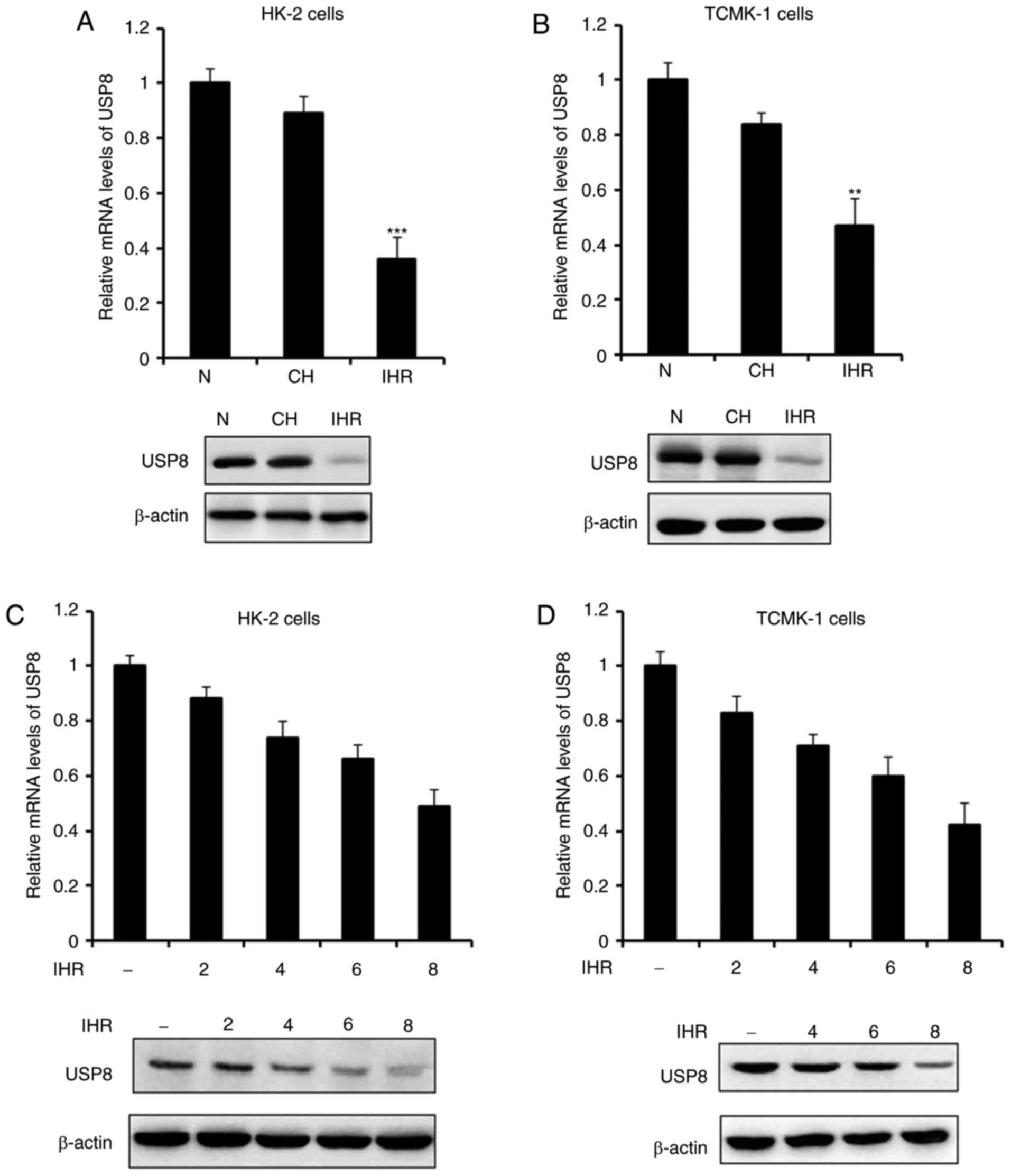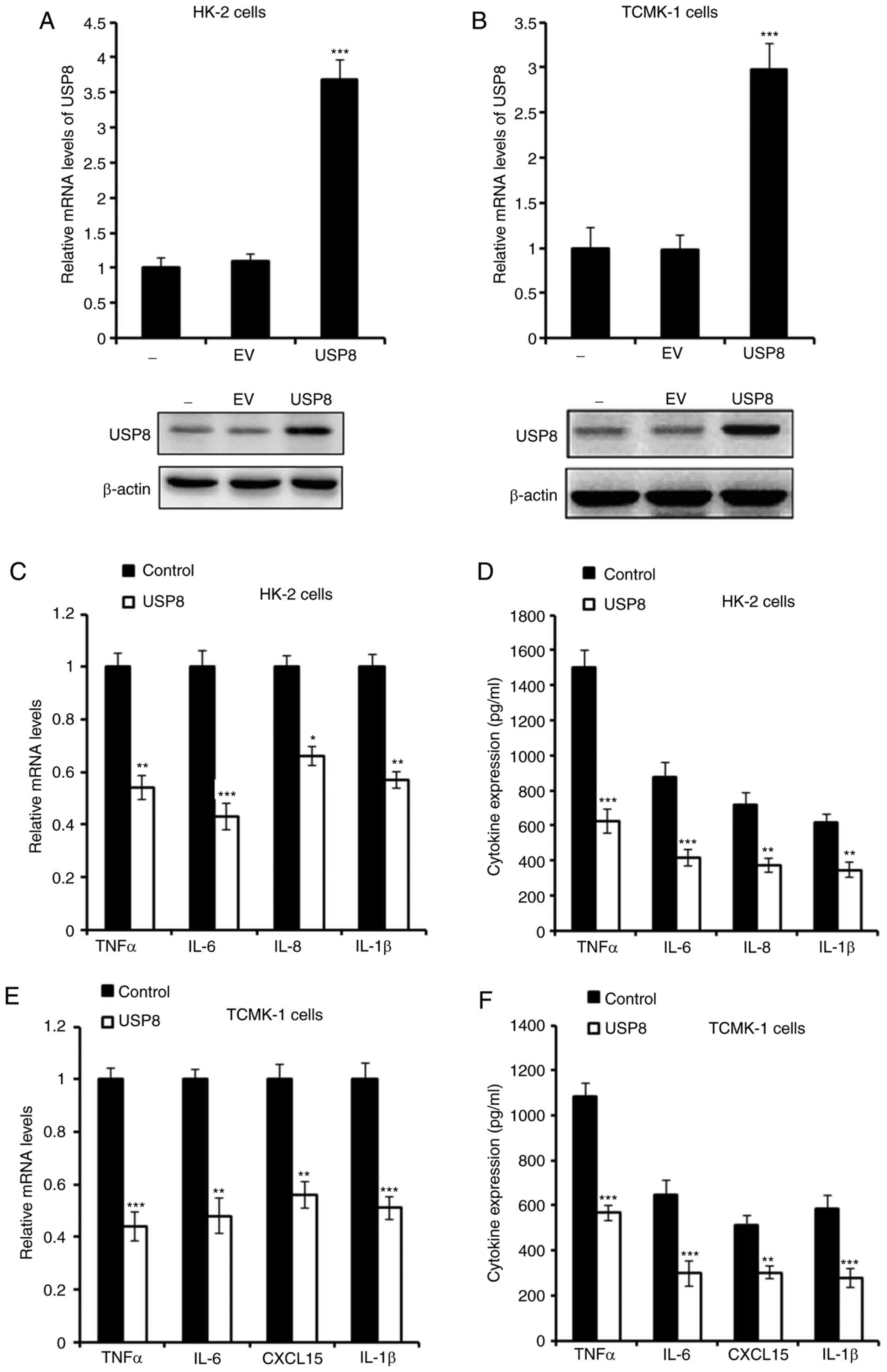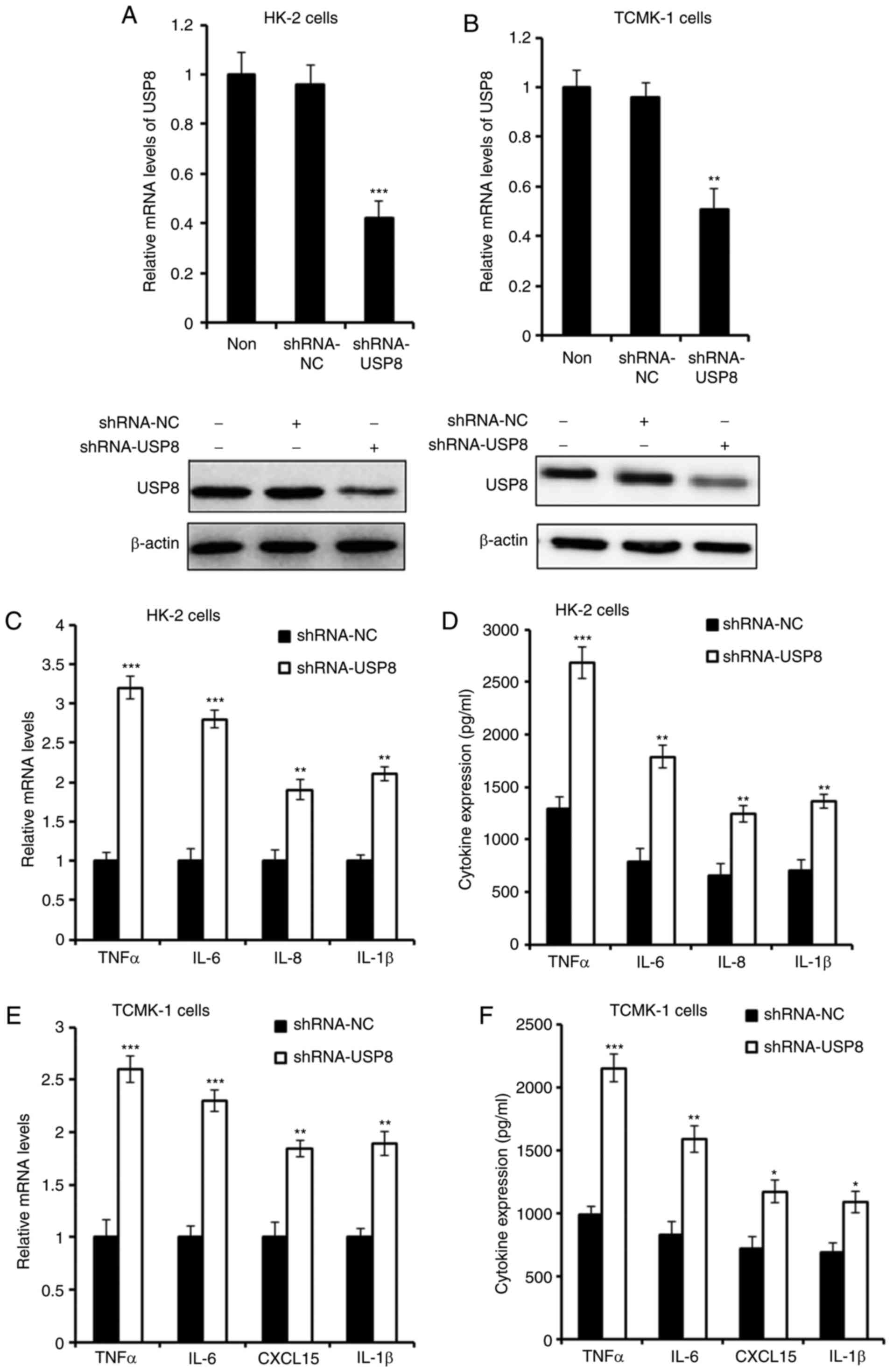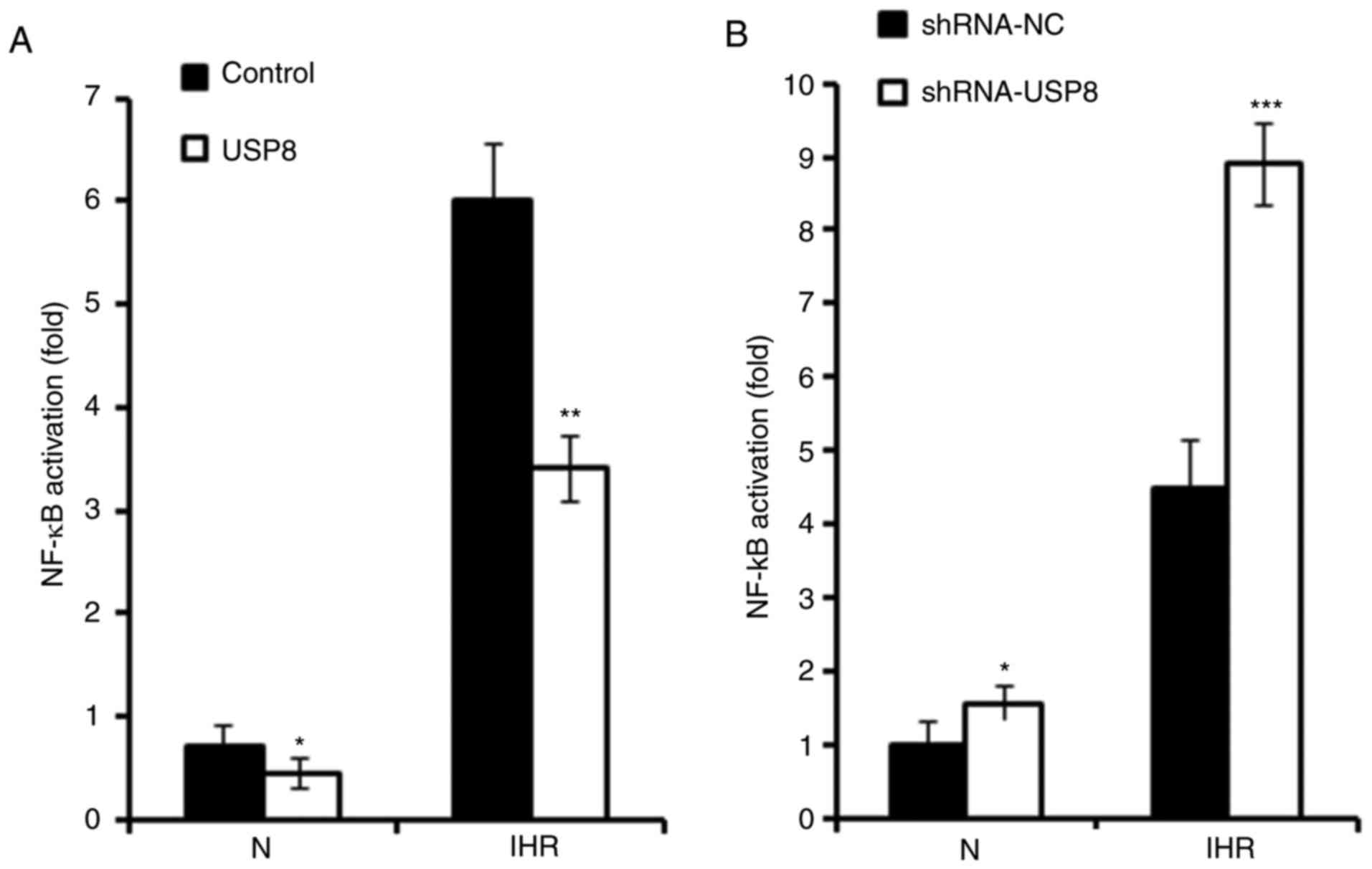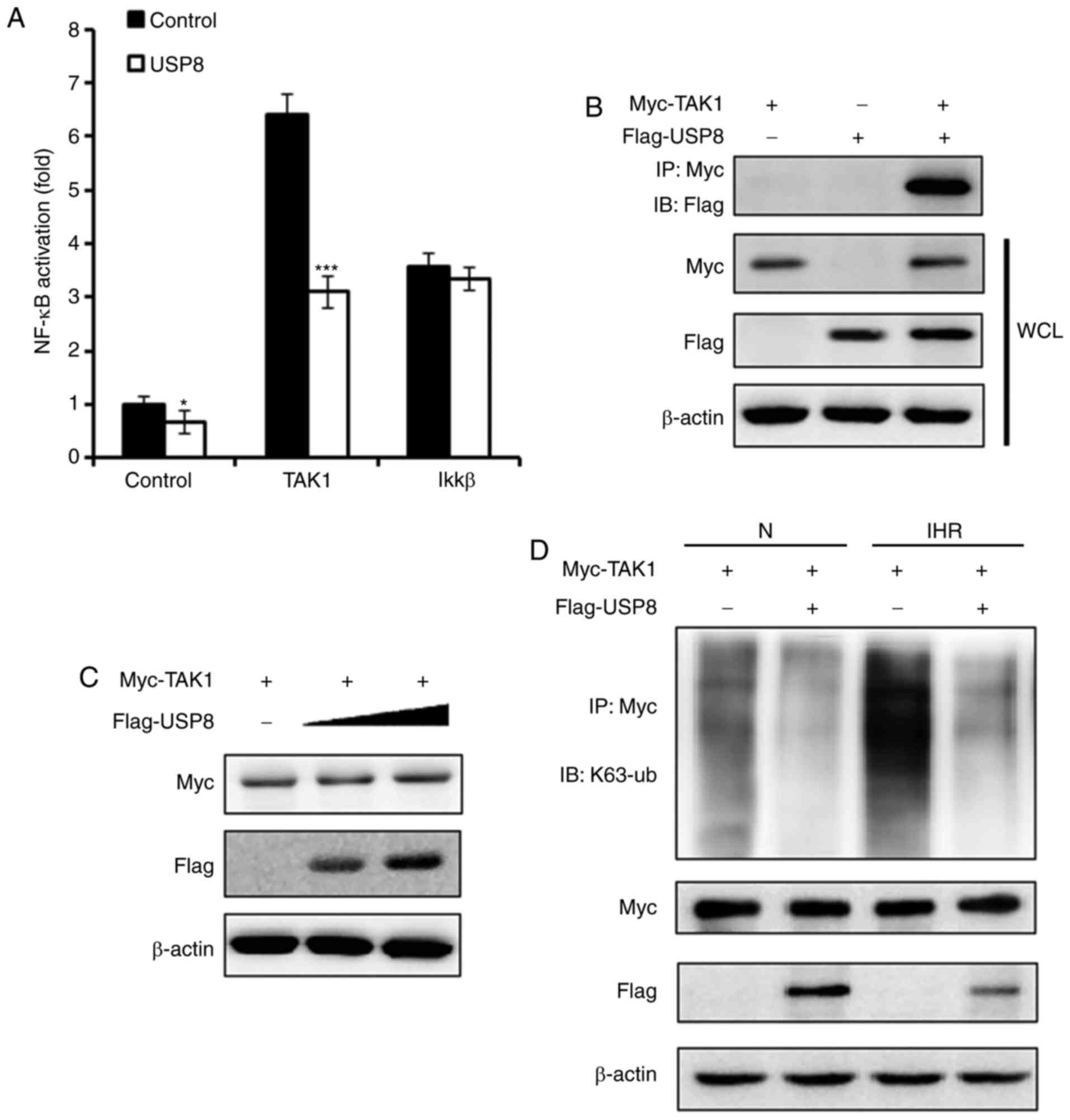Effect of deubiquitinase USP8 on hypoxia/reoxygenation‑induced inflammation by deubiquitination of TAK1 in renal tubular epithelial cells
- Authors:
- Published online on: September 17, 2018 https://doi.org/10.3892/ijmm.2018.3881
- Pages: 3467-3476
Abstract
Introduction
Intermittent hypoxia/reoxygenation (IHR) has been reported to contribute to the pathogenic process of obstructive sleep apnea (OSA); it also appears to be involved in promoting resistance to radiotherapy and chemotherapy in solid tumors, and is encountered in a wide range of respiratory and cardiac disorders, including chronic obstructive pulmonary disease and congestive cardiac failure (1-5). During these disease processes, IHR is always associated with increased reactive oxygen species (ROS) production, oxidative stress, and inflammation (6,7). Emerging evidence indicates that chronic kidney disease is a prevalent complication of untreated OSA with symptoms of polyuria and proteinuria (8,9). However, the precise mechanisms between these two diseases remain to be fully elucidated.
In contrast to the adaptation effect in response to continuous hypoxia (CH) through hypoxia-inducible factor 1 (HIF-1) signaling, the body undergoes tissue damage and cellular inflammation, mainly caused by nuclear factor-κB (NF-κB) signaling, following IHR challenge (10). NF-κB is considered the main pro-inflammatory family of transcription factors (11,12), NF-κB is released consequently and translocates to the nucleus where it activates the expression of NF-κB-related inflammatory genes (13). In this process, transforming growth factor-β-activated kinase-1 (TAK1) has been reported to be crucial through its kinase activity to phosphorylate and activate inhibitor of NF-κB (IκB) kinase (IKK) β, facilitating IKKβ-mediated IκBα degradation and downstream activation of NF-κB (14). However, the role of TAK1 in the IHR-induced activation of NF-κB has not been reported.
Deubiquitination is catalyzed by deubiquitinating (DUB) enzymes, which are proteases that cleave ubiquitin or ubiquitin-like proteins from target proteins (15). Ubiquitin-specific peptidase 8 (USP8; also known as Ubpy) is a cysteine protease and member of the ubiquitin-specific protease family of DUB enzymes capable of catalyzing the complete breakdown of K48- and K63-linked polyubiquitin into its component monomers (16,17). USP8 has an important physiological function in cell growth, and the deletion of USP8 causes embryonic death in mice (18,19). USP8 has been reported to negatively regulate the ubiquitination of epidermal growth factor receptor, neuregulin receptor degradation protein-1, and β-site amyloid precursor protein-cleaving enzyme to regulate the process of cell proliferation, neuroinflammation and neurological disorder (20-23). However, the effect of USP8 on IHR-induced inflammation and the underlying targets in the IHR-induced activation of NF-κB remain to be fully elucidated. The present study demonstrated for the first time, to the best of our knowledge, that the expression of USP8 was decreased in IHR conditions but not in normoxic or CH conditions in renal tubular epithelial cells. Furthermore, the overexpression of USP8 significantly suppressed IHR-induced pro-inflammatory cytokine expression and inhibited the activation of NF-κB. It was also observed that USP8 interacted with TAK1 and deubiquitinated the K63-linked ubiquitination of TAK1, leading to the inactivation of TAK1 and NF-κB. In conclusion, the present study revealed an anti-inflammatory role of USP8 in IHR-induced inflammation and suggested USP8 as a potential target for the treatment of IHR-related diseases.
Materials and methods
Cell culture and hypoxia treatment
The HK-2 (human renal tubular epithelial cells) and TCMK-1 (murine renal tubular epithelial cells) cells were purchased from the American Type Culture Collection (Manassas, VA, USA). These cells were cultured in Dulbecco's modified Eagle's medium (DMEM; Gibco; Thermo Fisher Scientific, Inc., Waltham, MA, USA) that was supplemented with 10% heat-inactivated fetal bovine serum (FBS; Gibco; Thermo Fisher Scientific, Inc.). The hypoxia treatment was performed as described previously (24). Briefly, for the normoxic cultures, the cells were cultured in a humidified incubator (37°C, 21% O2, 74% N2 and 5% CO2) for 48 h. For the CH cultures, the cells were grown in a sealed hypoxic incubator for 48 h (37°C, 1% O2, 94% N2 and 5% CO2). For the IHR cultures, the cells were subjected to a specified number of hypoxia (37°C, 1% O2, 94% N2 and 5% CO2) and reoxygenation (37°C, 21% O2, 74% N2 and 5% CO2) cycles; each hypoxia and reoxygenation cycle included 3 h of hypoxic incubation followed by 3 h of normoxic culture. When reoxygenated, the cell culture medium was replaced, and the culture dishes were placed into a normoxic chamber.
Plasmid and short hairpin (sh)RNA
The human USP8 and murine USP8 expression plasmids were purchased from Vigene Biosciences, Inc. (Jinan, China). Human USP8 and murine USP8 shRNA plasmids (cat. nos. 76975 and 76976) were purchased from Santa Cruz Biotechnology, Inc., (Dallas, TX, USA). For the transfection of plasmids into HK-2 and TCMK-1 cells, X-treme Gene 9 reagents were used according to the standard protocol (Roche Diagnostics, Basel, Switzerland). Following transfection, the cells were incubated at 37°C for 36 or 48 h to allow for maximal overexpression or knockdown of the target gene, and then exposed to eight cycles of IHR, followed by the examination of protein expression or inflammatory cytokine detection.
Dual-luciferase reporter gene assays
The experiment was performed as described previously (25). The NF-κB promoter plasmid and phRL-TK plasmid were obtained from Dr Guo Litao from Affiliated Hospital of Chengde Medical University (Chengde, China). The reporter plasmid was transfected into HK-2 cells using the Lipofectamine 2000 (Invitrogen, Thermo Fisher Scientific, Inc.), and the phRL-TK plasmid was cotransfected as internal control. A total of 36 h later, the cells were exposed to IHR treatment and the luciferase activities were measured on a SpectraMax M5 reader (Molecular Devices LLC, Sunnyvale, CA, USA) and normalized to Renilla luciferase activity using the Dual Luciferase Reporter Assay System (Promega Corporation, Madison, WI, USA).
RNA analysis
The cells were collected and TRIzol reagent (Invitrogen; Thermo Fisher Scientific, Inc.) was used to extract total RNA according to the manufacturer's protocol. The cDNA Reverse Transcription kit (Thermo Fisher Scientific, Inc.) was used for using 1 µg of total RNA from each sample according to the manufacturer's protocol. The temperature protocol was as follows: RNA and kit reagents were mixed and incubated for 2 min at 37°C in a water bath. Then the other components were added and incubated for 10 min at 25°C followed by 15 min at 50°C. The reaction was terminated by heating at 85°C for 5 min.
A LightCycler (ABI PRISM 7000; Applied Biosystems; Thermo Fisher Scientific, Inc.) and a SYBR RT-PCR kit (Takara Biotechnology Co., Ltd., Dalian, China) were used for reverse transcription-quantitative polymerase chain reaction (RT-qPCR) analysis. Reaction conditions for SYBR Green quantitative PCR were: Pre-denaturation at 95°C for 10 min; followed by 40 cycles of denaturation at 95°C for 15 sec, annealing at 60°C for 20 sec, and extension at 72°C for 20 sec. GAPDH was used as the internal control, and the 2-ΔΔCq method was used to evaluate the relative quantities of each amplified product in the samples (26). The primer sequences used in RT-qPCR analysis are presented in Table I.
Western blot analysis and immunoprecipitation (IP)
The cells were lysed using RIPA buffer (Thermo Fisher Scientific, Inc.), and total protein in the supernatants was quantified using a BCA protein assay kit (Thermo Fisher Scientific, Inc.). IP and western blot analysis were performed as described previously (27). Equal amounts of protein (50 µg protein per lane) were loaded on 10% SDS-PAGE for separating them and then transferred to polyvinylidene fluoride membranes (EMD Millipore, Billerica, MA, USA). Following blocking with 5% non-fat milk for 1 h, the membranes were probed with primary antibodies at 4°C overnight. The membranes were washed three times with TBS and 0.1% Tween 20 (TBST) the next day, and then incubated with HRP-conjugated anti-rabbit secondary antibodies (1:5,000; Santa Cruz Biotechnology, Inc.) for 1 h at room temperature. Following washing with TBST, the immunoreactive protein bands were visualized by using Western Blotting Luminol Reagent (cat no. sc-2048; Santa Cruz Biotechnology, Inc.) and detected with Quantity One software version 4.6.2 (Bio-Rad Laboratories, Inc.). The antibodies targeting USP8 (1:1,000; cat. no. 8728), p65 (1:1,000; cat. no. 8242), phosphorylated (p-)p65 (1:1,000; cat. no. 3033), IKKβ (1:1,000; cat. no. 8943), p-IKKβ (1:1,000; cat. no. 2697), Flag (1:1,000; cat. no. 14793), Myc (1:1,000; cat. no.2276), ubiquitin (linkage-specific K63; 1:500; cat. no. 5621) and β-actin (1:2,000; cat. no. 3700) were all purchased from Cell Signaling Technology, Inc. (Beverly, MA, USA).
Statistical analysis
All data are presented as the mean ± standard deviation of three experiments. Statistical significance was determined with (two-tailed) Student's t-test, P<0.05 was considered to indicate a statistically significant difference. All statistical analyses were conducted using SPSS software (SPSS program, version 13.0, SPSS, Inc., Chicago, IL, USA).
Results
Expression of USP8 is decreased in IHR-treated renal tubular epithelial cells
The present study first examined the expression of USP8 in normoxia, IHR or CH. As shown in Fig. 1A and B, the expression of USP8 was not affected by the CH conditions, however, it was significantly decreased in the IHR-treated HK-2 and TCMK-1 cells. The association between the expression of USP8 and IHR cycles was then examined. It was demonstrated that the mRNA and protein levels of USP8 were attenuated in a time-dependent manner (Fig. 1C and D), which indicated that, as the number of IHR cycles increased, the expression of USP8 was decreased.
Overexpression of USP8 alleviates IHR-induced inflammation
It has been reported that USP8 is essential in downregulating neuroinflammation (23); the present study investigate whether USP8 regulates the inflammation induced by IHR. First, USP8 was overexpressed in HK-2 and TCMK-1 cells, and the overexpression of USP8 was confirmed as shown in Fig. 2A and B. The mRNA and protein levels of pro-inflammatory cytokines were detected, and it was demonstrated that these cytokines, including tumor necrosis factor (TNF)-α, interleukin (IL)-6, IL-8 and IL-1β, were all downregulated in the USP8-overexpressing HK-2 cells following IHR challenge (Fig. 2C and D). Consistently, similar results were observed in the TCMK-1 cells (Fig. 2E and F).
Silencing of USP8 aggravates IHR-induced inflammation
An shRNA plasmid of USP8 was purchased to knock down the expression of USP8, and the effect of shRNAs was detected (Fig. 3A and B). As presented in Fig. 3C and D, the silencing of USP8 enhanced the IHR-induced production of TNF-α, IL-6, IL-8 and IL-1β in the HK-2 cells. Consistent with these overexpression results, it was found that the expression of pro-inflammatory cytokines in TCMK-1 cells was also increased following USP8 shRNA treatment in IHR conditions.
USP8 inhibits IHR-induced activation of NF-κB
It has been reported that IHR-induced inflammation occurs mainly through NF-κB signalling (10). The present study investigated whether USP8 also regulates IHR-induced pro-inflammatory cytokine production through the NF-κB pathway. As presented in Fig. 4A, a Dual-Luciferase Reporter Assay was used to examine the activation of NF-κB signaling, and it was found that the overexpression of USP8 significantly suppressed the activation of NF-κB in the IHR-treated HK-2 cells. Consistently, it was demonstrated that silencing of USP8 enhanced the IHR-induced activation of NF-κB (Fig. 4B). Subsequently, the phosphorylation of p65 and IKKβ was examined, and it was demonstrated that the overexpression of USP8 inhibited the IHR-induced phosphorylation of p65 and IKKβ (Fig. 4C and D).
USP8 interacts with TAK1 and deubiquitinates the K63-linked ubiquitination of TAK1
TAK1 has been demonstrated to be essential in regulating the activation of NF-κB (14). The present study examined whether USP8 regulates TAK1 and thus affects the NF-κB pathway. As presented in Fig. 5A, it was demonstrated that, following the overexpression of USP8, the TAK1-induced activation of NF-κB was suppressed, whereas IKKβ-induced NF-κB activation was not affected. IP experiments were performed to examine the interaction between TAK1 and USP8, and it was found that USP8 interacted with TAK1 (Fig. 5B). On examining whether the expression of TAK1 was regulated by USP8, however, it was observed that the expression of TAK1 was not affected by the overexpression of USP8 (Fig. 5C). USP8 is reported to be a deubiquitinating enzyme, and it has been reported to deubiquitinate the K63-linked ubiquitination of diverse targets (16,17), therefore, the present study examined the K63-linked ubiquitination level of TAK1. As shown in Fig. 5D, following IHR treatment, the overexpression of USP8 downregulated the K63-linked ubiquitination of TAK1, indicating that USP8 suppressed the activation of TAK1 through regulating TAK1 K63-linked ubiquitination.
Discussion
To the best of our knowledge, the present study is the first to demonstrate the essential role of USP8 in IHR-induced inflammation in renal tubular epithelial cells. It is also the first report to reveal that TAK1 is one of the targets of USP8 and provide evidence to illustrate that USP8 negatively regulates the activity of TAK1 through deubiquitinating the K63-linked ubiquitination of TAK1.
During the progression of acute kidney injury, renal tubular epithelial cells undergo ischemia and hypoxia, which include a series of events that cause pathological damage (28,29). Patients with severe OSA also exhibit a high prevalence of chronic kidney disease and it has been found to accelerate the loss of kidney function (30). Therefore, it is of significance to examine the underlying pathogenesis of the disease and identify other appropriate drug targets. In the present study, it was found that, in cultured human and murine renal tubular epithelial cells, the expression of USP8 was significantly decreased in IHR conditions, however, the expression of USP8 was not affected in CH conditions. It was hypothesized that this may relate to the oxidative stress and production of ROS induced by IHR, and future investigations aim to investigate this to confirm this hypothesis.
It has been reported that NF-κB-dependent inflammatory gene expression is induced by IHR (10). Consistent with previous studies, the present study found in renal tubular epithelial cells that the activation of NF-κB and pro-inflammatory cytokine production was increased in IHR conditions. It was also observed that USP8 markedly suppressed the IHR-induced activation of NF-κB and cytokine production, indicating that USP8 has an anti-inflammatory effect on IHR-induced inflammation. For the first time, to the best of our knowledge, the present study revealed that TAK1 is a target of USP8. TAK1 directly interacted with USP8, and the overexpression of USP8 significantly suppressed the TAK1-induced activation of NF-κB. These findings also indicated that TAK1 is the key regulator of IHR-induced pro-inflammatory cytokine production, which improves current understanding of TAK1-related diseases.
Ubiquitin has seven lysines (K6, K11, K27, K29, K33, K48 and K63), all of which can be conjugated to another ubiquitin to form a polyubiquitin chain through different lysine linkages to serve distinct functions in the cells (31). The K63-linked polyubiquitination of TAK1 has been reported to be crucial in the activation of TAK1 and NF-κB (32,33). In the present study, it was found that E3 ligase USP8 directly interacted with TAK1, but the overexpression of USP8 did not affect the expression of TAK1, indicating that the K48-linked polyu-biquitination of TAK1 was not regulated by USP8. Finally, it was observed that USP8 cleaved K63-linked polyubiquitin chains from TAK1 to inhibit TAK1 kinase activity, leading to the attenuated activation of NF-κB and IHR-induced inflammation. This provides novel ideas for drug development for IHR-related diseases, including OSA.
In conclusion, the present study found that the expression of USP8 was decreased in renal tubular epithelial cells in IHR conditions, and USP8 suppressed the IHR-induced activation of NF-κB and pro-inflammatory cytokine production, mainly through deubiquitinating the K63-linked ubiquitination of TAK1. The results demonstrated the role of USP8 in IHR-induced inflammation and suggested USP8 as a potential and specific therapeutic target for IHR-related diseases.
Acknowledgements
The authors would like to thank Dr. Guo Litao from the Affiliated Hospital of Chengde Medical University for providing plasmids.
Funding
The present study was supported by grants from Natural Science Foundation of China (grant nos. 30700890 and 81100059).
Availability of data and materials
The datasets used and/or analyzed during the current study are available from the corresponding author on reasonable request.
Authors' contributions
YWZ and YQL performed the experiments and drafted the manuscript. YW and HL assisted with the cell culture and western blot. YY and QW conceived and designed the study, analyzed and interpreted the data, and critically revised the manuscript. All authors read and approved the final manuscript.
Ethics approval and consent to participate
Not applicable.
Patient consent for publication
Not applicable.
Competing interests
The authors confirm that they have no competing interests.
References
|
Passali D, Corallo G, Yaremchuk S, Longini M, Proietti F, Passali GC and Bellussi L: Oxidative stress in patients with obstructive sleep apnoea syndrome. Acta Otorhinolaryngol Ital. 35:420–425. 2015. | |
|
Toffoli S and Michiels C: Intermittent hypoxia is a key regulator of cancer cell and endothelial cell interplay in tumours. FEBS J. 275:2991–3002. 2008. View Article : Google Scholar : PubMed/NCBI | |
|
Prabhakar NR: Oxygen sensing during intermittent hypoxia: Cellular and molecular mechanisms. J Appl Physiol. 90:1986–1994. 2001. View Article : Google Scholar : PubMed/NCBI | |
|
Agani F and Jiang BH: Oxygen-independent regulation of HIF-1: Novel involvement of PI3K/AKT/mTOR pathway in cancer. Curr Cancer Drug Targets. 13:245–251. 2013. View Article : Google Scholar : PubMed/NCBI | |
|
Wang Z, Wu S, Liao J, Zhong L, Xing T, Fan J and Peng Z: Interleukin-6 and rs1800796 locus single nucleotide polymorphisms in response to hypoxia/reoxygenation in hepatocytes. Int J Mol Med. 38:192–200. 2016. View Article : Google Scholar : PubMed/NCBI | |
|
Dyugovskaya L, Polyakov A, Lavie P and Lavie L: Delayed neutrophil apoptosis in patients with sleep apnea. Am J Respir Crit Care Med. 177:544–554. 2008. View Article : Google Scholar | |
|
Lavie L: Oxidative stress in obstructive sleep apnea and intermittent hypoxia-revisited-the bad ugly and good: Implications to the heart and brain. Sleep Med Rev. 20:27–45. 2015. View Article : Google Scholar | |
|
Nicholl DD, Ahmed SB, Loewen AH, Hemmelgarn BR, Sola DY, Beecroft JM, Turin TC and Hanly PJ: Clinical presentation of obstructive sleep apnea in patients with chronic kidney disease. J Clin Sleep Med. 8:381–387. 2012.PubMed/NCBI | |
|
Kimmel PL, Miller G and Mendelson WB: Sleep apnea syndrome in chronic renal disease. Am J Med. 86:308–314. 1989. View Article : Google Scholar : PubMed/NCBI | |
|
Ryan S, McNicholas WT and Taylor CT: A critical role for p38 map kinase in NF-kappaB signaling during intermittent hypoxia/reoxy-genation. Biochem Biophys Res Commun. 355:728–733. 2007. View Article : Google Scholar : PubMed/NCBI | |
|
Li D, Wang C, Li N and Zhang L: Propofol selectively inhibits nuclear factor-kappaB activity by suppressing p38 mitogen-activated protein kinase signaling in human EAhy926 endothelial cells during intermittent hypoxia/reoxygenation. Mol Med Rep. 9:1460–1466. 2014. View Article : Google Scholar : PubMed/NCBI | |
|
Lawrence T: The nuclear factor NF-kappaB pathway in inflammation. Cold Spring Harb Perspect Biol. 1:a0016512009. View Article : Google Scholar | |
|
Tian Y, Zhang Y, Zhong B, Wang YY, Diao FC, Wang RP, Zhang M, Chen DY, Zhai ZH and Shu HB: RBCK1 negatively regulates tumor necrosis factor- and interleukin-1-triggered NF-kappaB activation by targeting TAB2/3 for degradation. J Biol Chem. 282:16776–16782. 2007. View Article : Google Scholar : PubMed/NCBI | |
|
Shuto T, Xu H, Wang B, Han J, Kai H, Gu XX, Murphy TF, Lim DJ and Li JD: Activation of NF-kappa B by nontypeable Hemophilus influenzae is mediated by toll-like receptor 2-TAK1-dependent NIK-IKK alpha/beta-I kappa B alpha and MKK3/6-p38 MAP kinase signaling pathways in epithelial cells. Proc Natl Acad Sci USA. 98:8774–8779. 2001. View Article : Google Scholar | |
|
Nijman SM, Luna-Vargas MP, Velds A, Brummelkamp TR, Dirac AM, Sixma TK and Bernards R: A genomic and functional inventory of deubiquitinating enzymes. Cell. 123:773–786. 2005. View Article : Google Scholar : PubMed/NCBI | |
|
MacDonald E, Urbe S and Clague MJ: USP8 controls the trafficking and sorting of lysosomal enzymes. Traffic. 15:879–888. 2014. View Article : Google Scholar : PubMed/NCBI | |
|
Jeong M, Lee EW, Seong D, Seo J, Kim JH, Grootjans S, Kim SY, Vandenabeele P and Song J: USP8 suppresses death receptor-mediated apoptosis by enhancing FLIPL stability. Oncogene. 36:458–470. 2017. View Article : Google Scholar | |
|
Naviglio S, Mattecucci C, Matoskova B, Nagase T, Nomura N, Di Fiore PP and Draetta GF: UBPY: A growth-regulated human ubiquitin isopeptidase. EMBO J. 17:3241–3250. 1998. View Article : Google Scholar : PubMed/NCBI | |
|
Niendorf S, Oksche A, Kisser A, Löhler J, Prinz M, Schorle H, Feller S, Lewitzky M, Horak I and Knobeloch KP: Essential role of ubiquitin-specific protease 8 for receptor tyrosine kinase stability and endocytic trafficking in vivo. Mol Cell Biol. 27:5029–5039. 2007. View Article : Google Scholar : PubMed/NCBI | |
|
Alwan HA and van Leeuwen JE: UBPY-mediated epidermal growth factor receptor (EGFR) de-ubiquitination promotes EGFR degradation. J Biol Chem. 282:1658–1669. 2007. View Article : Google Scholar | |
|
Wu X, Yen L, Irwin L, Sweeney C and Carraway KL III: Stabilization of the E3 ubiquitin ligase Nrdp1 by the deubiquiti-nating enzyme USP8. Mol Cell Biol. 24:7748–7757. 2004. View Article : Google Scholar : PubMed/NCBI | |
|
Yeates EF and Tesco G: The endosome-associated deubiquiti-nating enzyme USP8 regulates bACE1 enzyme ubiquitination and degradation. J Biol Chem. 291:15753–15766. 2016. View Article : Google Scholar : PubMed/NCBI | |
|
Zhu L, Bi W and Lu D, Zhang C, Shu X, Wang H, Qi R, Shi Q and Lu D: Regulation of ubiquitin-specific processing protease 8 suppresses neuroinflammation. Mol Cell Neurosci. 64:74–83. 2015. View Article : Google Scholar | |
|
Litao L, Wenlan L, Lili W, Ting Z, Jianhua Z and Ni X: Hypoxiainducible factor 1 mediates intermittent hypoxiainduced migration of human breast cancer MDAMB231 cells. Oncol Lett. 14:7715–7722. 2017. | |
|
Guo L, Dong W, Fu X, Lin J, Dong Z, Tan X and Zhang T: Tripartite Motif 8 (TRIM8) positively regulates pro-inflammatory responses in Pseudomonas aeruginosa-Induced keratitis through promoting K63-Linked polyubiquitination of tAK1 protein. Inflammation. 40:454–463. 2017. View Article : Google Scholar | |
|
Kenneth J and Livak TD: Analysis of relative gene expression data using rea l-time quantitative PCR a nd the 2(-Delta Delta C(T)) Method. Method. 25:402–408. 2001. View Article : Google Scholar | |
|
Lin Y and Luo Z: NLRP6 facilitates the interaction between TAB2/3 and TRIM38 in rheumatoid arthritis fibroblast-like synoviocytes. FEBS Lett. 591:1141–1149. 2017. View Article : Google Scholar : PubMed/NCBI | |
|
Bonventre JV and Yang L: Cellular pathophysiology of ischemic acute kidney injury. J Clin Invest. 121:4210–4221. 2011. View Article : Google Scholar : PubMed/NCBI | |
|
Cantaluppi V, Quercia AD, Dellepiane S, Figliolini F, Medica D and De Lena M: New mechanisms and recent insights in the pathogenesis of acute kidney injury (AKI). G Ital Nefrol. 29:535–547. 2012.In Italian. PubMed/NCBI | |
|
Yayan J, Rasche K and Vlachou A: Obstructive sleep apnea and chronic kidney disease. Adv Exp Med Biol. 1022:11–18. 2017. View Article : Google Scholar : PubMed/NCBI | |
|
Adhikari A and Chen ZJ: Diversity of polyubiquitin chains. Dev Cell. 16:485–486. 2009. View Article : Google Scholar : PubMed/NCBI | |
|
Sorrentino A, Thakur N, Grimsby S, Marcusson A, von Bulow V, Schuster N, Zhang S, Heldin CH and Landström M: The type I TGF-beta receptor engages TRAF6 to activate TAK1 in a receptor kinase-independent manner. Nat Cell Biol. 10:1199–1207. 2008. View Article : Google Scholar : PubMed/NCBI | |
|
Fan YH, Yu Y, Mao RF, Tan XJ, Xu GF, Zhang H, Lu XB, Fu SB and Yang J: USP4 targets TAK1 to downregulate TNFα-induced NF-kappaB activation. Cell Death Differ. 18:1547–1560. 2011. View Article : Google Scholar : PubMed/NCBI |



